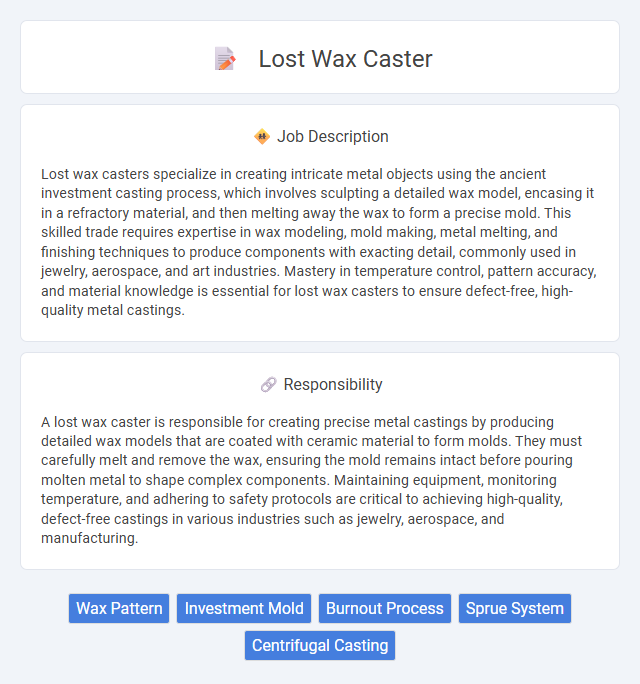
Lost wax casters specialize in creating intricate metal objects using the ancient investment casting process, which involves sculpting a detailed wax model, encasing it in a refractory material, and then melting away the wax to form a precise mold. This skilled trade requires expertise in wax modeling, mold making, metal melting, and finishing techniques to produce components with exacting detail, commonly used in jewelry, aerospace, and art industries. Mastery in temperature control, pattern accuracy, and material knowledge is essential for lost wax casters to ensure defect-free, high-quality metal castings.
Individuals with steady hands, patience, and attention to detail are likely well-suited for lost wax casting due to the intricate nature of the process. Those who prefer repetitive, precise tasks and can work in environments that may involve exposure to heat and chemicals may find this job suitable. People prone to sensitivity from fumes or lacking fine motor skills might be less likely to thrive in this role.
Qualification
Lost wax casters require expertise in pattern making, mold preparation, and metal casting techniques to accurately reproduce detailed metal components. Proficiency in interpreting technical drawings and knowledge of materials such as wax, ceramic, and various alloys are essential for precision and quality control. Experience with temperature regulation, mold curing, and casting defects detection ensures the production of defect-free metal parts in industrial and artistic applications.
Responsibility
A lost wax caster is responsible for creating precise metal castings by producing detailed wax models that are coated with ceramic material to form molds. They must carefully melt and remove the wax, ensuring the mold remains intact before pouring molten metal to shape complex components. Maintaining equipment, monitoring temperature, and adhering to safety protocols are critical to achieving high-quality, defect-free castings in various industries such as jewelry, aerospace, and manufacturing.
Benefit
A lost wax caster likely benefits from developing precise attention to detail and advanced metalworking skills, which can improve job security and career growth opportunities. The role may provide hands-on experience with diverse materials, increasing versatility and employability in various industries such as jewelry, aerospace, or art. Working in this field could also offer satisfaction through creating intricate, high-quality products, potentially enhancing personal fulfillment and professional reputation.
Challenge
Lost wax casters likely face the challenge of maintaining precision while working with intricate designs, as even minor errors can compromise the final product's quality. The job probably demands high attention to detail and steady hands to accurately reproduce complex patterns in metal. Adapting to new materials and evolving industry technologies may also present ongoing difficulties in this craft.
Career Advancement
A career as a lost wax caster offers specialized skills in metal casting used in industries like jewelry, aerospace, and art. Mastery of precision techniques in wax modeling, mold-making, and metal pouring enhances employability and opens pathways to supervisory or technical expert roles. Continuous skill development and certification in metallurgical processes can significantly accelerate advancement to lead caster or production manager positions.
Key Terms
Wax Pattern
Wax pattern creation is a critical phase in the lost wax casting process, requiring precision and attention to detail to ensure the final metal product's accuracy. Skilled lost wax casters sculpt or mold wax into exact replicas of the desired item, maintaining dimensional integrity and surface quality. The wax pattern serves as a sacrificial model that forms the mold cavity for metal casting, making its craftsmanship vital for defect-free castings.
Investment Mold
Lost wax casters specialize in creating precise investment molds that capture intricate details for metal casting. The investment mold, made from a refractory ceramic material, encases a wax model which is then melted away to form a cavity for molten metal. This technique ensures high-quality, complex metal components widely used in jewelry, aerospace, and automotive industries.
Burnout Process
The burnout process in lost wax casting involves carefully heating wax models to remove them without residue, creating a precise cavity in the ceramic mold. Controlled temperature ramps prevent mold cracking and ensure complete wax elimination, which is critical for casting accuracy and surface finish. Proper burnout cycles optimize metal flow and reduce casting defects such as porosity or incomplete fills in the final product.
Sprue System
The sprue system in lost wax casting serves as a critical channel for molten metal to flow seamlessly into the mold cavity, ensuring complete and defect-free castings. Designing an efficient sprue involves optimizing its diameter, length, and placement to maintain steady metal flow and minimize turbulence. Proper sprue system engineering prevents casting defects such as porosity and cold shuts, enhancing overall product quality and dimensional accuracy.
Centrifugal Casting
A lost wax caster specializing in centrifugal casting expertly creates precise metal components by using a molten metal poured into a wax-pattern mold rotated at high speeds. This technique ensures uniform metal distribution and exceptional surface detail, making it ideal for producing complex parts in aerospace, automotive, and jewelry industries. Mastery of temperature control and mold integrity is crucial to achieve high-quality, defect-free castings in this precise manufacturing process.
 kuljobs.com
kuljobs.com